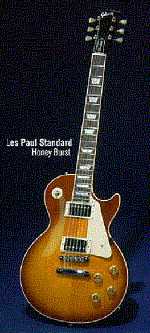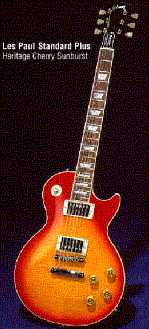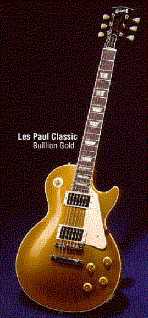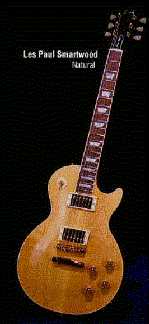The Headstock
Symmetry is a major part of the Les Paul's appeal and it starts with
the headstock - an elongated, shaped, slight trapezium with a scrolled
top
and curved sides. On the Standard model, this shape is echoed by the
tuning
pegs, again, symmetrically placed, 3 on each side of the headstock. On
the
Custom model, the tuning pegs are kidney-shaped. The bell-shaped
truss-rod
cover behind the nut completes the functional items on the headstock
which
is elegantly shaped and finished with the scrolled "Les Paul" legend on
the truss-rod cover.
The Neck

The rosewood neck offers a wide playing surface similar to acoustic
guitars and greater than other electrics, such as Fenders. Instead of
simple dots, Gibson use trapezoid-shaped, pearl, fret-marker inlays on
the Standard
model echoing the shape of the headstock and tuning pegs right up to
the
solid guitar body where the neck is glued into the body.
The Body
The body shape echoes an acoustic guitar but with a single, gracefully crafted cutaway below the neck to enable access to the upper frets. The body is made of solid mahogany that makes it heavier than comparable electric guitars and allegedly gives it extra sustain, though in the world of amplifiers and effects, how discernible this natural sustain is must be questionable. The top of the body is beautifully carved maple, uniquely cambering up from the body unlike most other electric guitars that have a simpler and more economically constructed flat face. This was a deliberate design ploy by Gibson to make the guitar harder to copy. The maple finishes available vary enormously with flat colours or natural effects but the best, in my view, is the Cherry Sunburst book-matched finish that completes the whole guitar and complements its styling perfectly.
The Hardware

The circular Rhythm/Treble control sits perfectly in the circular body area above the neck and the 4 circular Volume and Tone controls sit diametrically opposite within easy reach of the player's strumming hand. The jack socket is sited on the edge of the body, away from the body face, so as not to spoil the guitar's appearance. The simple, but effective, bridge sits behind 2 humbucking pickups: the neck pickup giving the warmest of blues tones and the bridge pickup giving the most distinctive of lead tones. The humbucking pickups were invented by Gibson engineer Seth Lover in 1955 and fitted to Les Pauls in 1957. They were designed to counter contemporary electric guitars' habit of generating hum signal that interfered with the natural sound of the amplified strings. Each pickup is effectively 2 magnetic coils wired in series but out of phase to cancel out the unwanted hum and deliver pure electric guitar sound. The added benefit is that the 2 magnetic coils within each of the Les Paul's pickups are positioned side-by-side thereby covering greater string width than single coil pickups, and in turn, greater tonal range. Up until 1960 the manufacture of these pickups was not to precisely defined production procedures - the magnetic coils were wound an approximate number of times and this resulted in varying depths of sound. This was mainly to the benefit of the overall sound of the guitars from this era making 1957-1960 Les Pauls amongst the most sought after guitars of all.
The Sonics

Though this is an outstandingly beautiful electric guitar design, musical instruments are for playing and that is where an instrument makes it, or not. The Les Paul sound is one of the most distinctive in popular music and for a long period, and at different times, has been the de facto rock sound. Probably at its best when coupled with Marshall amplification, it has an incomparable quality that is all its own.
The Models

Different models appeal to different tastes, and wallets, but are essentially the same classic design with less bells or more whistles: Studio, Classic, Smartwood, Custom, etc. For the less wealthy, the Studio is a great choice though you can go for an Epiphone copy if you're really strapped for cash and are prepared to have a non-US made model.
The Les Paul Custom is the Rolls-Royce of the range but can be just admired for its beauty than anything else with its gold hardware, inlays, binding and scrolling.
The Choice
Les Paul Standards cost between 2-3 times the cost of their main competitors: US-made Fender Strats. The price difference is due to the construction difference. Fender Strats have a bolt-on neck, flat face body, a tremolo arm that rarely keeps the strings in tune, and electrics that buzz, hum and often fail to work atall - mass production being the main objective. The sound of a Fender Strat is trademark, and been emulated by many cheaper and cheerful copyists, but it's clearly an instrument with a cheaper production assembly heritage. Conversely, a Les Paul has the look, feel, content and assembly of a fine instrument that is the product of more discerning design and construction objectives.
The Anecdote
The best music shop I've ever been in is the Guitar Center on Sunset
Boulevard, Hollywood, LA. The range of musical instruments there is
stunning and all are available to try out. Because (like in most
markets) what they're selling isn't unique, the difference is in the
service they provide and the staff there are simply superb. Extremely
knowledgeable and ever-willing to help they can't help but quickly
develop customer loyalty by the way they deal with the customers and
the products. Conversely, Rudy's
amd Manny's in New York are
a terrible disappointment. Manny's especially
has more photographs on the walls than guitars and much of what they're
selling is only fit for firewood at silly prices - it's as if whatever
the guitar is, if it's at Manny's it
somehow justifies a silly pricetag.
In many music shops, the shop assistant takes over: you ask to try out a musical instrument and the assistant insists on flexing his ego by showing off every little trill and trick he knows in the hope that you'll be enormously impressed by his virtuosity. They just don't get it that you want to get your hands on the instrument to decide whether you're going to buy it or not - not suffer terminal boredom by this ostentatious show of self-indulgence.
At Guitar Center, this never happens. They provide the goods, the means of trying them out and a no-pressure environment to make a free decision on if and what you're going to buy.
I went in there at the start of a week I was in LA and in a show-cabinet they had three Les Paul Standards on display: a 1958, a 1959 and a 1960. Guitar nirvana. If you don't already know, the 1959 Les Paul Standard is arguably the most desirable electric guitar of all time. The '59 wasn't in brilliant condition - the body varnish was cracked but at least it was a guitar that had been used and not purchased solely as an investment. I couldn't see the price on the '59 but knew it would be in the region of a brand new exotic luxury car. I went back four days later and the '59 Les Paul was gone. Someone had come in over the weekend and bought it there and then. Price: $62,000.
Maybe that brand new cherry sunburst Les Paul Standard I finally treated myself to doesn't look such a bad investment after all...
